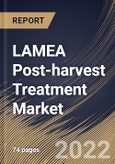The Latin America, Middle East and Africa Post-Harvest Treatment Market is expected to witness market growth of 9.3% CAGR during the forecast period (2021-2027).
Post-harvest treatments consisting minerals and primarily calcium are utilized in order to enhance the quality and storage life of various vegetables and fruits. Post-harvest treatments are being used for securing calcium in food and beverages. By increasing the amount of calcium in horticultural crops provide consumers with a better method of enhancing the calcium intake instead of consuming any supplements.
Post-harvesting management may offer such youth with good employment opportunities. People can get employed in harvesting, packing and transporting the fresh produce in towns and cities. Moreover, the excess quantity produced can be converted into value added products and pulps during the season by the help of post harvesting treatments.
Saudi Arabia is among the major producers of dates, figs, peaches, citrus and grapes. Also, dates are widely consumed in the Middle East region. Dates are required to be preserved in an arid climate with a little or no rainfall requirement in the region where it is cultivated. In regional market, there has been a growing need to prevent ripening of fruits. As a result, the finding that limiting fruit tissue respiration might delay ripening and hence extend storage time is an example of the importance of the field of post-harvest treatment.
The Brazil market dominated the LAMEA Post-harvest Treatment Market by Country 2020, and is expected to continue to be a dominant market till 2027; thereby, achieving a market value of $47.9 million by 2027. The Argentina market is expected to exhibit a CAGR of 9.9% during (2021 - 2027). Additionally, The UAE market is anticipated to grow a CAGR of 9% during (2021 - 2027).
Based on Type, the market is segmented into Coatings, Fungicides, Cleaners, Ethylene Blockers, Sanitizers and Sprout Inhibitors. Based on Crop Type, the market is segmented into Fruits and Vegetables. Based on countries, the market is segmented into Brazil, Argentina, UAE, Saudi Arabia, South Africa, Nigeria, and Rest of LAMEA.
The market research report covers the analysis of key stake holders of the market. Key companies profiled in the report include John Bean Technologies Corporation, BASF SE, Syngenta AG Group (China National Chemical Corporation), Fomesa Fruitech, United Phosphorus Ltd. (Decco), AgroFresh Solutions, Inc., Nufarm Limited, Sumitomo Chemical Co., Ltd., and Apeel Science.
Post-harvest treatments consisting minerals and primarily calcium are utilized in order to enhance the quality and storage life of various vegetables and fruits. Post-harvest treatments are being used for securing calcium in food and beverages. By increasing the amount of calcium in horticultural crops provide consumers with a better method of enhancing the calcium intake instead of consuming any supplements.
Post-harvesting management may offer such youth with good employment opportunities. People can get employed in harvesting, packing and transporting the fresh produce in towns and cities. Moreover, the excess quantity produced can be converted into value added products and pulps during the season by the help of post harvesting treatments.
Saudi Arabia is among the major producers of dates, figs, peaches, citrus and grapes. Also, dates are widely consumed in the Middle East region. Dates are required to be preserved in an arid climate with a little or no rainfall requirement in the region where it is cultivated. In regional market, there has been a growing need to prevent ripening of fruits. As a result, the finding that limiting fruit tissue respiration might delay ripening and hence extend storage time is an example of the importance of the field of post-harvest treatment.
The Brazil market dominated the LAMEA Post-harvest Treatment Market by Country 2020, and is expected to continue to be a dominant market till 2027; thereby, achieving a market value of $47.9 million by 2027. The Argentina market is expected to exhibit a CAGR of 9.9% during (2021 - 2027). Additionally, The UAE market is anticipated to grow a CAGR of 9% during (2021 - 2027).
Based on Type, the market is segmented into Coatings, Fungicides, Cleaners, Ethylene Blockers, Sanitizers and Sprout Inhibitors. Based on Crop Type, the market is segmented into Fruits and Vegetables. Based on countries, the market is segmented into Brazil, Argentina, UAE, Saudi Arabia, South Africa, Nigeria, and Rest of LAMEA.
The market research report covers the analysis of key stake holders of the market. Key companies profiled in the report include John Bean Technologies Corporation, BASF SE, Syngenta AG Group (China National Chemical Corporation), Fomesa Fruitech, United Phosphorus Ltd. (Decco), AgroFresh Solutions, Inc., Nufarm Limited, Sumitomo Chemical Co., Ltd., and Apeel Science.
Scope of the Study
Market Segments Covered in the Report:
By Type
- Coatings
- Fungicides
- Cleaners
- Ethylene Blockers
- Sanitizers and
- Sprout Inhibitors
By Crop Type
- Fruits and
- Vegetables
By Country
- Brazil
- Argentina
- UAE
- Saudi Arabia
- South Africa
- Nigeria
- Rest of LAMEA
Key Market Players
List of Companies Profiled in the Report:
- John Bean Technologies Corporation
- BASF SE
- Syngenta AG Group (China National Chemical Corporation)
- Fomesa Fruitech
- United Phosphorus Ltd. (Decco)
- AgroFresh Solutions, Inc.
- Nufarm Limited
- Sumitomo Chemical Co., Ltd.
- Apeel Science
Unique Offerings from the Publisher
- Exhaustive coverage
- The highest number of market tables and figures
- Subscription-based model available
- Guaranteed best price
- Assured post sales research support with 10% customization free
Table of Contents
Chapter 1. Market Scope & Methodology
Chapter 2. Market Overview
Chapter 3. LAMEA Post-harvest Treatment Market by Type
Chapter 4. LAMEA Post-harvest Treatment Market by Crop Type
Chapter 5. LAMEA Post-harvest Treatment Market by Country
Chapter 6. Company Profiles
Companies Mentioned
- John Bean Technologies Corporation
- BASF SE
- Syngenta AG Group (China National Chemical Corporation)
- Fomesa Fruitech
- United Phosphorus Ltd. (Decco)
- AgroFresh Solutions, Inc.
- Nufarm Limited
- Sumitomo Chemical Co., Ltd.
- Apeel Science
Methodology

LOADING...








